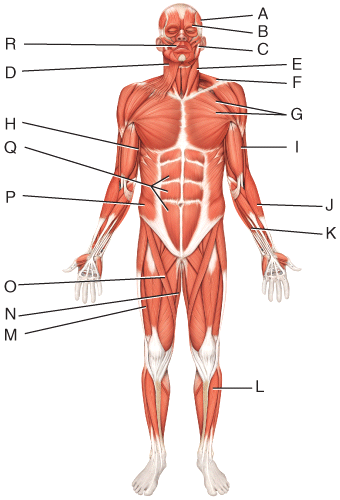
What is the antagonist of the muscle labeled B?
levator palpebrae superioris
Your friend nods back and forth to you, making the “yes” motion. What muscles are involved in this ‘yes’ motion? Select all that apply.
bilaterally sternocleidomastoid
bilaterally semispinalis capitis
bilaterally splenius capitis
bilaterally longissimus capitis
spinalis capitis
Your friend nods "yes" to you, going through flexion, extension and hyperextension. This movement at the fulcrum represents a
first-class lever system

Which muscle in this figure can abduct, medially and laterally rotate, and extend the arm at the glenohumeral joint?
F
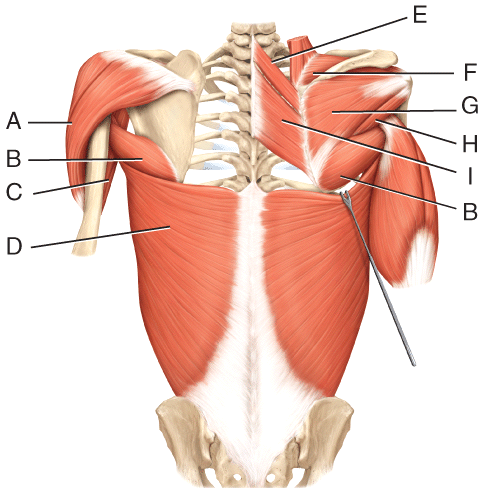
Which muscle in this figure elevates and adducts the scapula?
I
Which fascicle arrangement, under voluntary or involuntary regulation of contraction, can control the opening or closing an orifice (opening)?
Circular
“How much wood would a woodchuck chuck if a woodchuck could chuck wood” is difficult to say. What muscles work together to allow this to be spoken?
palatoglossus, styloglossus, genioglossus, hyoglossus
Most muscles cross at least one
joint
Which of these muscles flexes the thigh at the hip joint alone, but extends the knee working in a group?
rectus femoris
Forcefully blowing through a trumpet would require contraction of which muscle?
buccinator
Tim ate something that is not agreeing with his digestive tract. He needs to go to the bathroom to defecate, but there is a line. What muscle helps keep the anal canal and anus closed?
external anal sphincter
Which muscle’s insertion fuses with the calcaneal tendon? Select all that apply.
soleus
gastrocnemius
plantaris
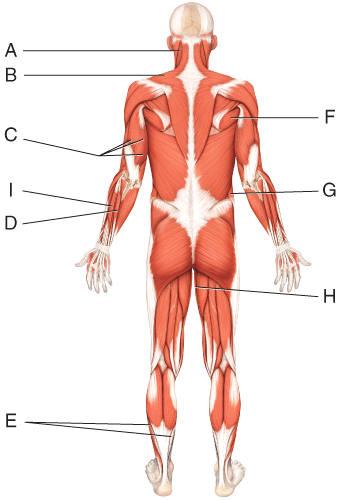
Acting unilaterally, which muscle in this figure can rotate the vertebral column?
G
Protrusion of an organ through a structure that normally contains it is referred to as a
hernia.
Which muscles have a triangular fascicle arrangement that spreads over a broad area and converges at a thick central tendon? Select all that apply.
pectoralis major
pectoralis minor
lattisimus dorsi

What is the action of the muscle labeled G?
adducts and medially rotates arm at shoulder joint

Where is the semitendinosus?
L
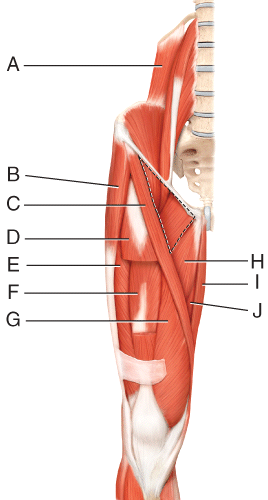
Where is the adductor longus?
H
The ______ are the synergist muscles to the diaphragm during inspiration.
external intercostals

What is the insertion of the muscle labeled G?
deltoid tuberosity of humerus
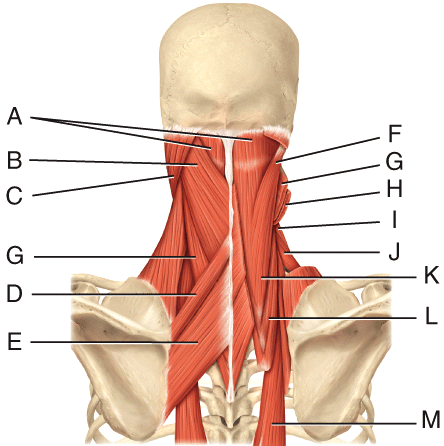
Which muscle in this figure is innervated by a cranial nerve and can flex the cervical portion of the vertebral column?
C
Based on its name, which of the following best describes characteristics of the biceps femoris muscle?
has two origins and found in the upper leg

Where is the iliacus?
A
Which of these groups includes only muscles that move the humerus but do NOT originate on the axial skeleton?
supraspinatus, teres major, teres minor, infraspinatus

Which muscle in this figure allows radial deviation at the wrist joint?
E
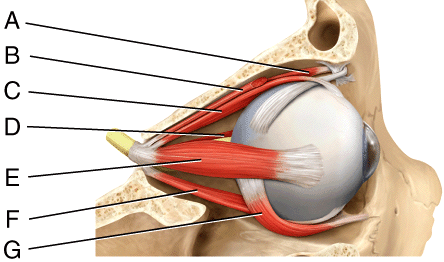
Which muscle in this figure elevates the upper eye lid?
B
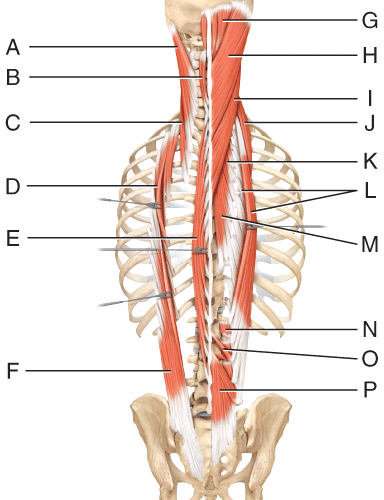
Which letter identifies the splenius capitis in this figure?
H
A 1 year old child presents with crossed eyes. While she seems fine and is able to recognize people, the patient is diagnosed with
strabismus.

Where is the sartorius?
C
What terms can be used to describe forearm muscle movements at the wrist but NOT on the fingers at the interphalangeal joints?
abduction and adduction
When the knee is being flexed, what is the fulcrum?
Knee joint
Motion will occur at a lever system when
effort at the insertion exceeds the load.

Fascia over deltoid and pectoralis muscles are the origin of the muscle labeled
D
Which muscles help expel urine in both males and females? Select all that apply.
external urethral sphincter
bulbospongiosus
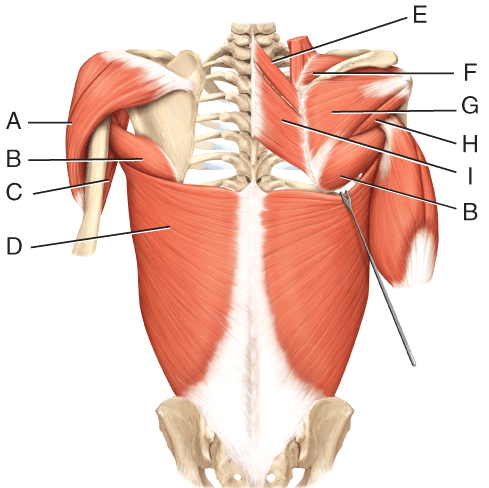
The tendon of which muscle in this figure is the most commonly damaged in rotator cuff injuries?
F
If one is stabbed on the lateral side of the abdomen, what abdominal muscles, in order from superficial to deep, will the knife go through?
external oblique, internal oblique, transversus abdominis
During knee flexion, what is the effort?
contraction of hamstring muscle group
Which muscles help move the jaw during mastication?
masseter, temporalis, pterygoid (medial and lateral)
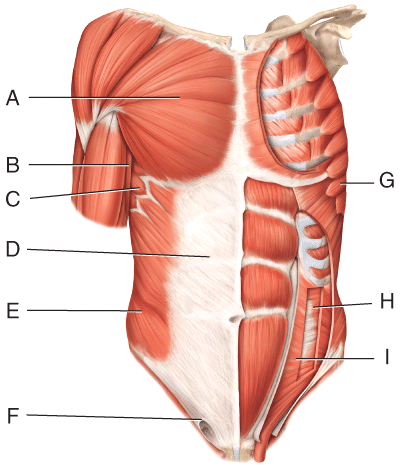
Which muscles in this figure compress the abdomen? Select all that apply.
E, H
Which of the following is a muscle whose insertion is found on the clavicle and acromion process of the scapula within the pectoral girdle?
trapezius

Which letters in this figure identify the serratus anterior? Select all that apply.
C & G

Which muscle in this figure is innervated by the trigeminal nerve?
E
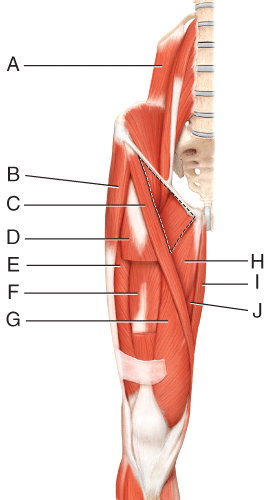
Which muscle originates at the anterior and lateral surfaces of the femoral body?
F
During inhalation, _____ muscles contract to elevate the ribs. During forced exhalation, ______ muscles contract to depress the ribs.
external intercostals; internal intercostals

Which muscles in this figure are involved in pouting? Select all that apply.
N, O
This muscle, which is found in the neck, functions to elevate the hyoid bone and help press the tongue against the roof of the mouth during swallowing.
mylohyoid
Your friend nods back and forth to you, making the yes motion. What lever system is being represented by this ‘yes’ motion?
First-class lever

What is the action of the muscle labeled I?
flexes the forearm at the elbow joint

Where is the abductor digiti minimi?
E
The rhomboid major is named for what characteristics? Select all that apply.
Size, Shape
Your friend nods back and forth to you, making the “yes” motion. What muscle actions on the head at the neck are involved in this ‘yes’ motion?
extension and flexion

Where is the depressor anguli oris?
L

What is the insertion of the muscle labeled D?
calcaneus by way of Achilles tendon
The muscle that serves as the “prime mover” during a movement is called the
agonist.

Which muscles in this figure are NOT innervated by the facial nerve? Select all that apply.
B, A
Due to the muscle attachments, a fracture to the ischial tuberosity would affect what lower limb movement?
flexion of the leg

What is the insertion of the muscle labeled Q?
cartilage of the fifth to seventh rib and xiphoid process

Which of these muscles has an insertion on the occipital bone and temporal bone?
B

Where is the gracilis?
I
Robert is training for a track race. He slightly tears his calcaneal tendon. The doctors prescribe P.R.I.C.E and give him medicine for inflammation and pain. Robert most likely has a
muscle strain
Which motions can be made by the upper limbs but NOT by the lower limbs?
pronation and supination

Which muscle in this figure produces the effort when you plantar flex to see over a taller person in front of your view?
D
The attachment of a muscle’s tendon to the stationary bone is called the _____; the attachment of the muscle’s other tendon to the movable bone is called the _____.
origin, insertion

Where is the orbicularis oculi?
D
Which of these muscles has fascicles parallel to the midline?
rectus femoris

Which muscles in this figure flex the forearm? Select all that apply.
A, C
Tapping your fingers against the table, similar to typing on a keyboard would use what muscles? Select all that apply.
Flexor digitorum profundus
Flexor digitorum superficialis
Extensor digitorum
Extensor digiti minimi

Which muscles in this figure elevate the upper lip? Select all that apply.
E, F

Which three muscles make up the hamstring?
L, M, N
A woman complains of problems going up steps. Tests reveal hip extension weakness but no issues with hip flexion or knee flexion or extension. What muscle is most likely damaged?
Gluteus maximus
The knee (tibiofemoral) joint can be described by what statements? Select all that apply.
The force is applied between the fulcrum and the resistance.
Produces a mechanical disadvantage.
Third-class lever

Which of these muscles have origins that begin on ribs 5? Select all that apply.
E, H, G

Which muscles in this figure are innervated by the oculomotor nerve? Select all that apply.
B, C, D, F, G
This type of muscle works by stabilizing the origin of the agonist so that it can act more efficiently.
fixator